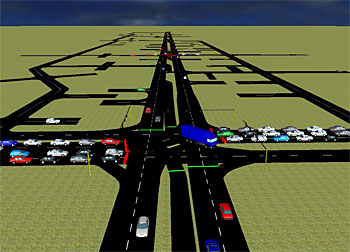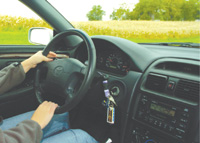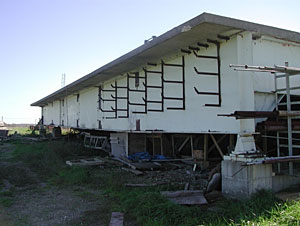Researchers
Tom Maze
Neal Hawkins
hawkins@iastate.edu email >Director Research Administration, ISU
Christian Sax
About the research
In urban communities, there are often limited amounts of right-of-way available for establishing a large setback distance from the curb for fixed objects. Urban communities must constantly weigh the cost of purchasing additional right-of-way for clear zones against the risk of fixed object crashes. From 2004 to 2006, this type of crash on curbed roads represented 15% of all fatal crashes and 3% of all crashes in the state of Iowa. Many states have kept the current minimum AASHTO recommendations as their minimum clear zone standards; however, other states have decided that these recommendations are insufficient and have increased the required minimum clear zone distance to better suit the judgment of local designers.
This report presents research on the effects of the clear zone on urban curbed streets. The research was conducted in two phases. The first phase involved a synthesis of practice that included a literature review and a survey of practices in jurisdictions that have developmental and historical patterns similar to those of Iowa. The second phase involved investigating the benefits of a 10 ft clear zone, which included examining urban corridors in Iowa that meet or do not meet the 10 ft clear zone goal. The results of this study indicate that a consistent fixed object offset results in a reduction in the number of fixed object crashes, a 5 ft clear zone is most effective when the goal is to minimize the number of fixed object crashes, and a 3 ft clear zone is most effective when the goal is to minimize the cost of fixed object crashes.
Funding Sources:
Iowa Department of Transportation
Iowa Highway Research Board ($79,814.00)
Midwest Transportation Consortium
Total: $79,814.00
Researchers
David Plazak
Hillary Isebrands
Eric Fitzsimmons
About the research
Significant transportation agency resources are allocated to meet maintenance, operations, safety, and air quality goals. Although there is a significant amount of overlap between these areas, decisions to meet agency goals in one area often do not consider goals in the others and, as a result, miss opportunities to leverage funds and make better informed decisions overall.
There are a number of areas of overlap between capital improvements designed to improve operations, maintenance, safety, and air quality goals that provide a rich opportunity to leverage funds and use resources more cost-effectively while meeting agency goals in two or more of the areas.
The objective of this research is to develop analytical tools that can efficiently evaluate common capital projects used to meet agency goals in one area (operations, safety, air quality, and maintenance) but that also have a significant impact on the others.
Funding Sources:
Iowa Department of Transportation
Midwest Transportation Consortium
Minnesota Department of Transportation
Researchers
Fouad S. Fanous
Krishna Kallam
Patrick Stein
About the research
The Iowa DOT currently owns and maintains over 4,000 bridges and culverts on the state highway system. With heightened concern for the condition of these aging structures, methods for assessing and maintaining the structural performance of in-service bridges have become vital to the preservation of Iowa’s bridge network. An economical data acquisition system that is portable and can be efficiently used on bridge structures could supplement visual inspections with field-measured values. By pursuing simplicity in the system interface and installation, tests could be completed by persons with limited engineering background. This concept can prevent bridges from being replaced that are thought to be structurally deficient and help estimate bridge condition in the database. This report summarizes a research project for the Iowa Department of Transportation (Iowa DOT) to develop, implement, and operate an integrated bridge asset management system for the state of Iowa. The system is Pontis, first developed in 1989 and currently used by around 45 transportation agencies, both in the United States and internationally. This system will enable the Iowa DOT to make objective, cost-effective, and timely decisions regarding bridge maintenance, rehabilitation, and replacement.
Funding Sources:
Iowa Department of Transportation ($75,004.00)
Midwest Transportation Consortium
Total: $75,004.00
Researchers
Tom Maze
Neil Burke
About the research
The Highway Economic Requirements System (HERS) is an economic model that uses highway performance monitoring system (HPMS) data to project future highway conditions and requirements. HERS is a highly complex model that, at the national level, uses samples of the highway network taken from the HPMS data. As a result, at the national level it is only used for aggregate network-level analysis (planning-level analysis). When the Federal Highway Administration?s Office of Asset Management was established in 1999, the office began developing the state version of HERS, or HERS-ST. HERS-ST has since evolved into a model that is specifically crafted for states.
A DOS version of HERS-ST was demonstrated at a workshop attended by representatives of several state transportation agencies in 2001. Since then, several improvements have been made to the software, including updates for a Windows environment and the addition of GIS capabilities. The current project yielded a HERS-ST specifically for Iowa, but one that can be used as a model for other states.
The initial goals of this project included customizing the HERS-ST software for the Iowa primary network, training Iowa Department of Transportation (Iowa DOT) employees to use the HERS-ST software, and holding a regional HERS-ST training seminar. The final task involved integrating the Iowa DOT training experience into Federal Highway Administration (FHWA) training materials and working with the FHWA Office of Asset Management to deliver HERS-ST training seminars to other states.
The final report describes the steps used to customize the HERS-ST software, explains the run analyses performed using HERS-ST that would benefit the Iowa DOT, and summarizes the concepts that were included in the HERS-ST training seminar for the Iowa DOT.
Funding Sources:
Iowa Department of Transportation ($50,000.00)
Midwest Transportation Consortium ($50,000.00)
Total: $100,000.00
Researchers
Song-Charng Kong
About the research
Commercial carriers are being confronted with a variety of decisions regarding long-term petroleum dependency and near-term state and federal policies aimed at increasing the use and content of biodiesel. The purpose of this study is to help members of the Iowa Motor Truck Association identify problems regarding the use of using biodiesel blends in trucks. The participating trucking company provided two trucks that ran on similar routes, one truck using regular diesel fuel (B0) and the other one using a 2% biodiesel blend (B2). Complete mileage data and special maintenance concerns were recorded over a period of approximately one year. Iowa State University researchers analyzed and interpreted the field data in terms of fuel economy, variations in maintenance, and seasonal performance. Data acquired from July 2006 through May 2007 were analyzed. Special attention was paid to the concern of fuel filter plugging resulting from using B2. During the period of this study, the B0 truck accumulated approximately 160,000 miles and the B2 truck accumulated about 120,000 miles. Field results indicate that both fuels provided similar miles per gallon numbers, even for different trip lengths. The average miles per gallon were 6.0 for the B0 truck and 6.1 for the B2 truck. Overall, the fuel economies of the two engines using B0 and B2 were very similar. In addition, no fuel filter plugging incidents in the B2 truck were found, even during the winter months. The final data are encouraging in terms of using B2 as an alternative fuel for trucks.
Funding Sources:
Midwest Transportation Consortium
Researchers
Charles Nemmers
About the research
This report synthesizes the safety corridor programs of 13 states that currently have some type of program: Alaska, California, Florida, Kentucky, Minnesota, New Jersey, New Mexico, New York, Ohio, Oregon, Pennsylvania, Virginia, and Washington. This synthesis can help Midwestern states implement their own safety corridor programs and select pilot corridors or enhance existing corridors. Survey and interview information about the states? programs was gathered from members of each state department of transportation (DOT) and Federal Highway Administration (FHWA) division office.
Topics discussed included definitions of a safety corridor; length and number of corridors in the program; criteria for selection of a corridor; measures of effectiveness of an implemented safety corridor; organizational structure of the program; funding and legislation issues; and engineering, education, enforcement, and emergency medical service strategies. Safety corridor programs with successful results were then examined in more detail, and field visits were made to Kansas, Oregon, Pennsylvania, and Washington for first-hand observations.
With the survey and field visit information, several characteristics of successful safety corridor programs were identified, including multidisciplinary (3E and 4E) efforts; selection, evaluation, and decommissioning strategies; organization structure, champions, and funding; task forces and Corridor Safety Action Plans; road safety audits; and legislation and other safety issues. Based on the synthesis, the report makes recommendations for establishing and maintaining a successful safety corridor program.
Funding Sources:
Midwest Transportation Consortium
University of Missouri – Columbia
Project Details
05/01/07
07/31/08
Midwest Transportation Consortium
Missouri Department of Transportation
University of Missouri - Columbia
Researchers
Glenn Washer
Brent Rosenblad
About the research
- Develop an instrumented pile capable of monitoring the thermal and seismic behavior at a bridge foundation
- Deploy an instrumented pile under simulated field conditions
- Assess the effectiveness of the remote monitoring system for asset management
Abstract
A key challenge to managing fixed assets such as bridges and other transportation infrastructure is monitoring their condition over time. Under typical service conditions, deterioration resulting from traffic loading and difficult environmental conditions can result in a reduction or loss of service of a particular asset, or even life threatening and dangerous failures. Extreme events such as earthquakes and floods present a still greater challenge in that the service condition of the asset may change abruptly and without warning, leaving managers without key information they need to respond to the event. The goal of this project is to develop remote health monitoring technology that will provide managers and owners with timely information on the condition of civil infrastructure assets. This will be achieved through the development of an instrumented pile that will provide real-time data on bridge scour and seismic activity, allowing for the remote monitoring of bridge conditions by key managers and engineers.
Potential Benefits of the Project:
- Enable widespread remote monitoring of more than 26,000 scour critical bridges in the U.S.
- Provide foundation for remote health monitoring systems for culverts, tunnels and highway bridges in general
Funding Sources:
Midwest Transportation Consortium
Missouri Department of Transportation
University of Missouri – Columbia
Researchers
Linda Boyle
About the research
The goal of this study was to explore the effects of drivers? personal characteristics and the in-car and out-car conditions associated with a car crashes on the types of crashes that drivers are most likely to be involved in.
It was hypothesized that personal and environmental characteristics surrounding a car crash will affect the types of crashes the drivers get involved in. Also, it was hypothesized that some differences in crash type patterns exist among the four Midwestern states (Iowa, Kansas, Missouri, and Nebraska) and between the Midwest and the country as a whole. The results of this study confirmed that these differences do exist.
Another goal of this study was to analyze the effect of different types of driver distractions on the crash types drivers get involved in. The results of this analysis showed that different sources of distraction lead to different types of crashes.
Funding Sources:
Midwest Transportation Consortium
University of Iowa
Researchers
J. Erik Loehr
About the research
Asset Management principles and systems share common goals and objectives with Load and Resistance Factor Design (LRFD) techniques. Asset management seeks to facilitate cost-effective maintenance, upgrade, and operation of physical assets in a systematic way. LRFD methods seek to produce cost-effective design decisions based on rational evaluation of performance, rather than judgment and experience of individual designers. Despite similar goals and objectives, there has to date been no attempt to integrate, or even relate, these techniques and they remain as essentially independent approaches. The project proposed here seeks to integrate the techniques specifically for the design and management of earth slopes and earth retention. Potential Benefits of the Project Potential to extend to other applications such as pavements, bridges, tunnels, and other applications where both asset management and LRFD techniques are currently utilized.
Funding Sources:
Midwest Transportation Consortium
University of Missouri – Columbia
Project Details
03/01/07
06/30/09
Federal Highway Administration
Midwest Transportation Consortium
Researchers
Brent Rosenblad
About the research
This project investigated the application and implementation of stress-wave based methods for assessing the integrity of concrete bridge decks. The ultimate objective is to develop reliable and economical non-destructive evaluation (NDE) techniques that evaluate the condition of concrete bridge decks in the field with limited traffic disruption. Experimental and theoretical studies were conducted on guided stress waves (Lamb waves) in concrete plates. Field measurements were performed on a full-scale concrete bridge deck located at the Remote Testing Facility (RTF) at the University of Missouri, Columbia. Measurements were performed using a variety of sensor and source orientations, including the placement of sensors on the opposite side of the concrete deck from the source. Energy was excited using vertically and horizontally oriented broadband source impacts. Dispersion curves were successfully developed from a single-sensor, multi-impact approach and a frequency-wavenumber transformation procedure. The dispersion curves that were developed demonstrated the ability to detect and separate multiple Lamb wave modes that could be used to infer the thickness and Rayleigh wave velocity of the concrete deck.
A second series of field experiments was performed on a concrete element containing simulated defects at several depths. The implementation of the approach described above proved ineffective for clearly detecting the presence and depth of the flaws. Additional measurements of Lamb waves propagating past the subsurface defects demonstrated the potential to identify the presence and depth of flaws based on changes in the frequency content of the wave. These measurements have provided valuable insight into potential means to implement stress-wave measurements for defect detection in bridge decks.
Funding Sources:
Federal Highway Administration
Midwest Transportation Consortium



